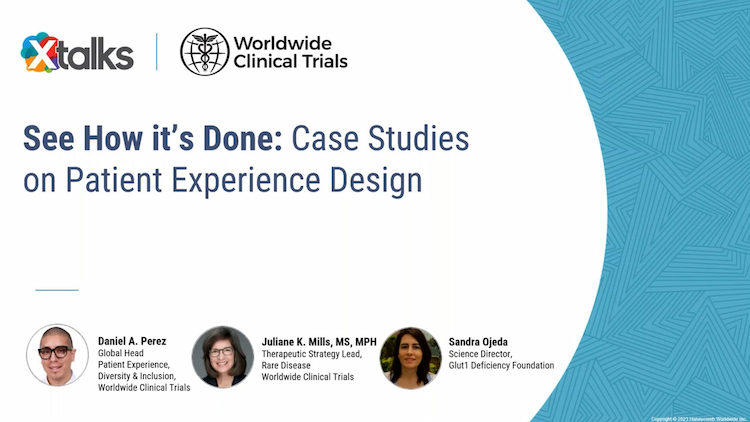
With the necessary prioritization of various factors when designing your clinical trial, the patient experience can be overlooked or improperly addressed in study design. However, incorporating the patient experience into your design is one of the best ways to ensure your drug development program is a commercial success. It plays a significant role in patient recruitment and retention, both of which are vital to maintaining timelines, decreasing program costs, and gaining market approval.
But how can the patient experience be leveraged to drive your trial’s success? In our recent Xtalks webinar, “See How It’s Done: Case Studies on Patient Experience Design,” our Therapeutic Strategy Lead, Rare Disease, Juliane K. Mills, MS, MPH, and Director & Global Head of Health Equity Strategy, Daniel A. Perez, CCRP are joined by Sandra Ojeda, PhD, the Science Director of the Glut1 Deficiency Foundation to discuss specific case studies from their experiences incorporating the patient experience into clinical trial design.
Among the various topics discussed, here are a few highlights of the panelists’ conversation:
Challenging Traditional Approaches
As an industry, Perez points out that we tend to stick to what we are accustomed to in terms of protocol design and traditional clinical operations. However, Perez challenges us to rethink our longstanding assumptions of clinical operations and study design, particularly regarding the patient experience.
Rather than following the traditional approach, it’s crucial to consider the different perspectives of all stakeholders involved, including sponsors, CRO partners, sites, patients, and caregivers. Perez uses the analogy of blind mice meeting an elephant for the first time to convey how easy it is to make sweeping assumptions based on limited experiences from your own perspective. “And, frankly, none of them are wrong. From a combined perspective, somewhere along the way, we tend to be able to land at what is the true design of clinical research,” says Perez. Each stakeholder understands operational gaps in unique ways, and when unexpected challenges arise during drug development that disrupt the model, it’s important to be open-minded to new approaches.
Perez expands on this by discussing how he was able to problem-solve in a global Phase 2 rare disease study for a small biotech when a large sponsor had recently introduced a compound on the market. The competition, paired with recruitment challenges due to the COVID-19 pandemic, led to complex operational challenges. Find out how he solved them by challenging the traditional structure in the full webinar.
Understanding the Patient Experience to Determine Study Endpoints
During the panel, Dr. Ojeda discusses the importance of understanding the patient experience in an indication to determine study endpoints, with Glut1 Deficiency as a prime example. Glut1 Deficiency is a rare disease where glucose isn’t transported into the brain properly, resulting in multiple metabolic consequences that create a wide range of neurological symptoms. The Glut1 Deficiency Foundation Dr. Ojeda represents aims to diagnose early, treat effectively, and cure this condition completely.
With this goal in mind, the foundation began the Collective Voices project, which included a survey among patients around the world. Although 31 countries participated, including several in South America and Asia, the highest percentage of patient respondents came from the following countries:
- 44%: U.S. (28 states)
- 8%: United Kingdom
- 6%: Italy
- 5%: Germany
- 4%: Canada
The survey’s purpose was to understand what affects their quality of life most, what types of symptoms they experience, patient and family research priorities, and more. The research provides valuable data to sponsors and researchers regarding what is most important to patients with these conditions.
“There are endpoints that can be easily measured, that are already standardized, and they are FDA-approved,” says Dr. Ojeda. However, she urges sponsors to try to understand the patient community first before launching a clinical trial so they can understand the patients’ needs and wants. For example, in response to “Priority Outcomes for New Treatments,” the foundation expected “fewer movement issues” and “fewer seizures” to be a top priority. However, the top three responses were:
- 35%: Able to eat a normal diet
- 27%: Improved cognition
- 25%: Better speech/communication
Taking the time to capture this research is not an easy task to accomplish, but the results show the value of an evidence-based approach and how it can help build clinical plans based on the collected data. You can learn more about this project on their website or by watching the full webinar.
Addressing Diversity During Patient Recruitment
Another essential aspect of clinical trial design is ensuring that the enrolled patient population is representative of the affected patient population. Dr. Mills addresses this topic when discussing a study for a rare cardiomyopathy indication that had a higher prevalence among patients with African and Caribbean ancestry. “I like to take a data-driven approach to my strategies, and so based on that information, we were targeting cardio centers in the U.S. that were located in high populations of patients with black and Caribbean ancestries,” says Dr. Mills.
They were successfully enrolling the study; however, a majority of the enrolled participants were white. Since the initial strategy on geolocation failed to enroll a representative population, the team implemented some mediations, such as:
- Educating the study teams on the importance of including this particular patient population
- Engaging with a professional organization focused on black cardiologists in the U.S. to improve connections in the community
- Deliberately not selecting sites that had more community-based physicians due to the nature of the indication
You can find more details on what Dr. Mills learned from this experience and how she plans to ensure representative enrollment in the future in the full webinar.
Paving the Way for Patient-Centric Clinical Research
Patient experience design can have a transformative impact on the outcome of your drug development program. For more information on how you can leverage your patient’s experience in your program, check out the full webinar.
Worldwide Clinical Trials has built relationships with more than 105 patient advocacy groups to better support the advancement of rare disease research. To discuss how we can support your trial, contact us.



